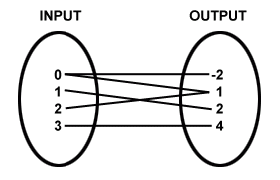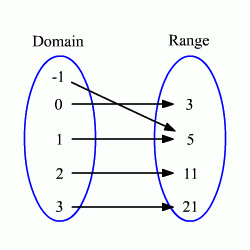You are familiar with the terms Domain and Range of a Function let’s dive deep into the article to know what a function is. You need to be familiar with relations to better understand the concept of functions. A relation is a rule that relates an element from one set to the other set. The function is a special kind of relation.
Suppose a Relation F from Set A to B. A Relation F is said to be a function if each element in Set A is associated with only one element in Set B. Understand the difference between Relation and Domain by checking out the following sections.

Fig 1 Arrow Diagram for Relation R
The above diagram Fig 1 is an example of relation because it relates elements from one set to the other set.

Fig 2 Arrow Diagram for Function F
Fig 2 is an Example of Function since each element in set A is associated with only one element in Set B. It is not related to more than one element thus it is a function.
- Relations and Mapping
- Ordered Pair
- Cartesian Product of Two Sets
- Relation in Math
- Domain and Range of a Relation
- Practice Test on Math Relation
- Functions or Mapping
- Math Practice Test on Functions
Domain and Range of a Function
Do remember that the domain might not be the same in the left arrow diagram. This is because some of the elements in the Set may not have images in the other set whereas, in the case of functions, the domain will always be the first set. However, Range and Codomain are similar to the way they are defined in Relations.
Consider function f represented from A to B i.e. f: A → B (f be a function from A to B), then
● Set A is the domain of the function ‘f’
● Set B is the co-domain of the function ‘f’
● The set of all f-images of all the elements of A is known as the range of “f’ and is denoted by f(A).
The set of all Possible values considered as inputs of the function is called the Domain of the function. Set of all the outputs of a function are known as Range of a Function.
Solved Examples on Domain Codomain and Range of a Function
1. Does the arrow diagrams mentioned below represents mapping? Give reasons supporting your answer?

Solution:
The above diagram depicted is Mapping since each element in Set A is associated with only one element in Set B.
2. Does the arrow diagrams mentioned below represent mapping? Give reasons supporting your answer?

Solution:
In the above arrow diagram element 2 in Set X is associated with B, C in Set Y. In fact, few elements in Set X are not related. Thus, the arrow diagram is not a Mapping.
3. Find out whether R is a mapping from A to B or not?
(i) Let A = {1, 2, 3} and B= {4, 5, 6, 7} and R = {(1, 4) (2, 5) (3, 6)}
(ii) Let A = {4, 5, 6} and B= {7, 8} and R = {(4, 7); (5, 8); (6, 7); (6, 8)}
Solution:
(i) Let A = {1, 2, 3} and B= {4, 5, 6, 7} and R = {(1, 4) (2, 5) (3, 6)}
Since, R ={(1, 4) (2, 5) (3, 6)} then Domain (R) = {1, 2, 3} = A
No two ordered pairs have the same first components therefore, R is a Mapping From A to B.
(ii) Let A = {4, 5, 6} and B= {7, 8} and R = {(4, 7); (5, 8); (6, 7); (6, 8)}
Since R = {(4, 7); (5, 8); (6, 7); (6, 8)}
Ordered Pairs (6, 7), (6, 8) has the same first components R is not a Mapping from A to B.
4. Let A = {0, 1, 2} and B = {0, 1, 3, 6, 7, 9}
Consider a rule f (x) = 2x² + 1, x∈A, then
Solution:
Using f (x) = 2x² + 1, x ∈ A we have
f(0)= 2*0+1 = 1
f(1) = 2*1+1 = 3
f(2) =2*4+1= 9
Every element in Set A has a unique image in Set B. Thus, f is a Mapping from A to B.